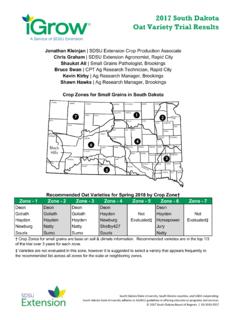Transcription of Strawberries in South Dakota - iGrow
1 Page 1 | A Service of SDSU Extension | 2016, South Dakota Board of RegentsStrawberries can be grown in most areas of South Dakota as they are adapted to a wide range of soil and climatic conditions. The fruit is tasty and nutritious, being particularly high in vitamin C and several antioxidants. Strawberries are very productive plants for the space they occupy. A planting of 25 June-bearing Strawberries will fill a 50 foot matted row and should produce 25-30 quarts of fruit. Everbearing plants grown in a raised bed can produce one-half to one quart of berries per plant.
2 Types of StrawberriesThere are three basic types of Strawberries : Junebearing, Everbearing, and Day-neutral Strawberries ; all are types of Fragaria x Strawberries are the most common type of strawberry grown in South Dakota . These Strawberries initiate runners to form new plants during the long days of midsummer, and initiate flower buds only under the short days of fall. The flower buds then go dormant until the following year. As the name suggests, Junebearing Strawberries produce one crop of fruit in the early summer between June and mid-July, depending on the variety.
3 They should not be allowed to fruit the year of planting, so that their energy is put into building the plant for future production. Honeoye, Sparkle, and Jewel are popular Junebearing strawberry varieties grown in South Dakota Everbearing Strawberries are also grown in South Dakota . They tend to produce most heavily in the spring and less in the fall. Everbearing Strawberries do not produce as many runners as Junebearing Strawberries . Fort Laramie and Ogallala are two popular everbearing strawberry varieties.
4 These are not usually used in commercial alpine strawberry (Fragaria vesca) is a small white- or red-fruited form of everbearing strawberry. The plants are low yielding and do not runner heavily but produce small soft fruit with intense flavor. Alpine Strawberries are most frequently used as an ornamental or novelty item, often grown in hanging baskets or gardens since they tolerate light shade. Day-neutral Strawberries are a newer type of everbearing strawberry that fruit from June through the first frost; they also seldom form runners, and are often grown as annuals as they can be harvested the year of planting.
5 The day-neutrals form flower buds and fruit continuously, whereas the everbearing Strawberries generally have two peak periods of production. However, day-neutral Strawberries do not form flower buds at temperatures above 85 F. They are recommended only where mulching, shading, or sprinkler irrigation can be used to provide a cool midsummer environment to promote continuous flowering. Tribute and Tristar are two examples of day-neutral in South DakotaRhoda Burrows | Professor & SDSU Extension Horticulture Specialist Anne Fennell | SDSU ProfessorgardensSDSU DEPARTMENT OFPLANT SCIENCESJANUARY Hansen, University of MinnesotaPage 2 | A Service of SDSU Extension | 2016, South Dakota Board of Regents | gardensVariety SelectionNew varieties are introduced every year, but not all are suited to this region.
6 Plant new varieties on a small scale to test their performance before establishing a large planting. Consider harvest season, disease resistance, size, color, firmness, flavor and freezing/processing characteristics when selecting cultivars (see Table 1). Order plants early (midwinter), from a reputable nursery to get high-quality, virus-free plants of the desired quality. Have orders delivered between April 15 and May 1 for spring planting in South Dakota . The number of plants needed depends on the planting design (see spacing recommendations in the section on establishing Strawberries ).
7 To avoid disease problems, always obtain healthy, virus-free plants from a reliable nursery rather than transplanting from an established SiteStrawberries require a site that has full sun at least 8 to 10 hrs per day. They can be grown on a variety of soil types, provided the soil is well drained and properly prepared. Avoid areas where water stands or drains very slowly; waterlogged soils can kill the roots through oxygen deprivation and root rot diseases. To avoid problems in heavy soils, use raised beds (at least 6- to 8-inches high) or plant on a 2-3% slope.
8 Even on well-drained soils, avoid low-lying sites because cold air will move to these sites, creating a potential for frost damage. A well-drained sandy loam with pH is optimal. Strawberries are sensitive to high salt content in the soil; it should not exceed mmho/cm. Soil salt content and pH can be easily determined through a soil test (contact your regional extension office for more information on soil testing). If necessary, soil pH may be lowered by incorporating elemental sulfur to a depth of 6 to 8 inches prior to planting.
9 An application of 5-10 lbs elemental sulfur per 100 square feet will lower the pH from to If your soil pH is higher than , additional sulfur will be needed to neutralize the free lime that is in the soil before the pH can be reduced. On some soils with high carbonate levels, sulfur will not be effective; check with your soil testing Strawberries near a source of good quality water for irrigation. Do not use water with a high sodium or salt content. High salinity and high pH are problems in many parts of South Dakota that can cause failure of a strawberry planting.
10 Do not use artesian water or any other water source unless you know it is of good quality with less than 700-900 ppm salts. Irrigation water can be tested for salinity; contact your regional SDSU Extension office for water sample collecting and testing information. Avoid sites that have had potatoes, tomatoes, eggplants, peppers, raspberries or Strawberries growing on them within the last 3 years. These plants can host Verticillium wilt, which can readily spread to the Strawberries . Before Planting: Site PreparationGood site preparation is the key to developing a long-term, high-yielding strawberry planting.










